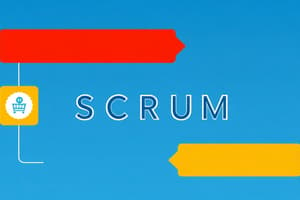Podcast
Questions and Answers
What is the primary focus of the Kanban method?
What is the primary focus of the Kanban method?
- Reducing the amount of work in progress at all costs
- Maximizing the workforce involved in production
- Visualizing work and optimizing flow (correct)
- Implementing a strict schedule for tasks
Which practice is NOT part of the Kanban principles?
Which practice is NOT part of the Kanban principles?
- Respect the current processes and roles
- Enforce strict deadlines for task completion (correct)
- Implement feedback loops
- Encourage acts of leadership at all levels
Which estimating method is primarily used for planning small to medium-sized tasks in Agile?
Which estimating method is primarily used for planning small to medium-sized tasks in Agile?
- T-Shirt Sizing (correct)
- Waterfall Method
- Gantt Charts
- Critical Path Analysis
What is a key difference between lead time and cycle time in Kanban?
What is a key difference between lead time and cycle time in Kanban?
In the context of Agile Reporting, which term refers to the amount of work completed within a specific timeframe?
In the context of Agile Reporting, which term refers to the amount of work completed within a specific timeframe?
Which of the following accurately describes Agile methodology?
Which of the following accurately describes Agile methodology?
What is the primary purpose of Scrum ceremonies?
What is the primary purpose of Scrum ceremonies?
What role does the Product Owner play in the Scrum framework?
What role does the Product Owner play in the Scrum framework?
Which of the following is NOT considered a concrete Agile framework?
Which of the following is NOT considered a concrete Agile framework?
During standup meetings, team members should answer which of the following questions?
During standup meetings, team members should answer which of the following questions?
How often does Sprint Planning typically occur in Scrum?
How often does Sprint Planning typically occur in Scrum?
What is a key benefit of Agile methodologies?
What is a key benefit of Agile methodologies?
Which of the following represents the maximum size of a Scrum team?
Which of the following represents the maximum size of a Scrum team?
What is the primary goal of a sprint review?
What is the primary goal of a sprint review?
Which role primarily keeps the backlog refined during backlog refinement?
Which role primarily keeps the backlog refined during backlog refinement?
During a retrospective, which question is typically not asked?
During a retrospective, which question is typically not asked?
What is a common time duration for a sprint review?
What is a common time duration for a sprint review?
What does the MoSCoW prioritization method stand for?
What does the MoSCoW prioritization method stand for?
What is an important aspect of defining a 'ready runway' in backlog refinement?
What is an important aspect of defining a 'ready runway' in backlog refinement?
What is one of the guiding questions used during backlog refinement?
What is one of the guiding questions used during backlog refinement?
Which retrospectives method asks participants to identify actions under 'Start doing', 'Stop doing', and 'Continue doing'?
Which retrospectives method asks participants to identify actions under 'Start doing', 'Stop doing', and 'Continue doing'?
Flashcards
Kanban
Kanban
A workflow management method that visualizes tasks, limits work in progress, and focuses on continuous improvement.
Lead Time
Lead Time
A common metric in Kanban that represents the time it takes to complete a task from start to finish.
Limit Work in Progress (WIP)
Limit Work in Progress (WIP)
A key Kanban practice that restricts the number of tasks being worked on simultaneously.
Retrospective (Kanban)
Retrospective (Kanban)
Signup and view all the flashcards
Kanban Board
Kanban Board
Signup and view all the flashcards
What is Agile?
What is Agile?
Signup and view all the flashcards
What are the Agile Values?
What are the Agile Values?
Signup and view all the flashcards
What are some Agile Frameworks?
What are some Agile Frameworks?
Signup and view all the flashcards
Who are the key personas in Scrum?
Who are the key personas in Scrum?
Signup and view all the flashcards
What is a Stand-up?
What is a Stand-up?
Signup and view all the flashcards
What is Sprint Planning?
What is Sprint Planning?
Signup and view all the flashcards
What is the goal of a Sprint Retrospective?
What is the goal of a Sprint Retrospective?
Signup and view all the flashcards
What is a Sprint Review?
What is a Sprint Review?
Signup and view all the flashcards
Sprint Review
Sprint Review
Signup and view all the flashcards
Sprint Retrospective
Sprint Retrospective
Signup and view all the flashcards
Backlog Refinement
Backlog Refinement
Signup and view all the flashcards
Prioritization Methods
Prioritization Methods
Signup and view all the flashcards
MoSCoW Prioritization
MoSCoW Prioritization
Signup and view all the flashcards
Impact vs Effort Matrix
Impact vs Effort Matrix
Signup and view all the flashcards
Kano Model
Kano Model
Signup and view all the flashcards
Relative Weighting Method
Relative Weighting Method
Signup and view all the flashcards
Study Notes
Agile Methodologies
- Agile is a set of principles for software development emphasizing flexibility, collaboration, and customer satisfaction.
- Agile responds to change quickly and delivers functional software frequently.
Agile Values (Manifesto)
- Agile prioritizes individuals and interactions over processes and tools.
- It values working software over comprehensive documentation.
- Agile values customer collaboration over contract negotiation.
- Agile prioritizes responding to change over following a plan.
Agile Frameworks
- Scrum
- Kanban
- eXtreme Programming
- Lean Software Development
- Scaled Agile Framework (SaFE)
- Spotify Model (not a framework)
- Other frameworks exist
Scrum - What Do You Know About It?
- Scrum is an agile framework.
- Scrum utilizes specific roles.
Key Personas in Scrum
- Product Owner: Decides what to do and why, focuses on work improvement.
- Scrum Master : Focuses on how to work better.
- Dev Team: Developers, testing, UX, DevOps performing the work
- Scrum Team size is no more than 10 people
Scrum Ceremonies
- Stand-ups: Daily briefings about progress and blocks by each member.
- Sprint planning: Planning for sprint activities over a period of time (1-4 weeks)
- Backlog refinement: Ensures team understands backlog items before execution.
- Sprint Review: Demonstrating work and getting feedback
- Retrospectives: Reflecting on the sprint and identifying areas for improvement
Stand-ups
- Purpose: Inspect and adapt, communicate improvements, highlight promotive decision making.
- Prerequisites: JIRA board and constant time and place.
- Deliverable: Team alignment, JIRA updated, progress towards sprint goal.
Sprint Planning - How To Do It?
- Occurs every sprint, ideally every 2 weeks, max 4 hours.
- Checks team capacity against highest priority user stories.
- Takes as many stories as possible to fit within the timebox.
- Example: Sprint planning excel sheet
Sprint Review - How To Do It?
- Occurs at the end of a sprint, ideally 1 - 1.5 hours.
- Team members present their completed work.
- Scrum Master and Product Owner facilitate collecting feedback.
- Requirements for participation include: team and stakeholder attendance, a working demo of the sprint’s output.
Retrospectives - How To Do It?
- Actions for ways to improve the working of the team.
- Includes what went well, what went bad, actions to improve, start, stop, and continue.
- Resources include: Miro Templates, https://www.funretrospectives.com/, and more.
Backlog Refinement - How To Do It?
- Prioritized backlog and backlog refinement based on the needed time.
- Backlog is defined as 'ready' to be accepted for sprints.
- Time for backlog refinement is up to 8 hours per sprint.
- Scrum master helps facilitate in the refinement.
Prioritization Methods (Decision Making)
- MoSCoW method used for prioritizing requirements.
- Impact vs Effort Matrix can help in prioritization by categorizing tasks based on their impact and effort.
- Relative weighting method combines criteria scores for prioritization.
- RICE model factors in reach, impact, confidence, and effort for prioritization.
MoSCoW Method
- Categorizes requirements into: Must have, Should have, Could have, Will not have.
- Must have are essential to project completion.
- Should have are important, but not necessary.
- Could have are desirable, but with a low impact if absent.
- Will not have requirements are not a priority during a specific timeframe.
Kano Model
- Describes user satisfaction levels based on features.
- Basic needs are must-have criteria to avoid dissatisfaction.
- Performance criteria create a sense of satisfaction based on how effectively it works.
- Delights provide extra satisfaction beyond basic and performance criteria.
Estimates & Sizing
- Story Points (planning Poker game)
- T-Shirt Sizing (Small, Medium, Large, Extra Large)
- Hours Estimates
- Affinity Mapping
Planning Poker Game
- Used to estimate the size of tasks in a project.
Affinity Mapping Exercise
- Used to categorize information effectively.
Reporting in Scrum
- Burn down (representing the work remaining, decreased vertically over time)
- Burn up (representing the work completed, increased vertically over time)
- Velocity (average amount of work that can be completed during a sprint).
Reporting in Kanban
- Lead time (time between receiving a request to completing it)
- Cycle time (time between beginning and completing an activity).
- Throughput (units produced per time period).
Studying That Suits You
Use AI to generate personalized quizzes and flashcards to suit your learning preferences.




